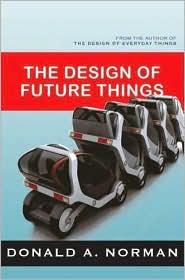Comment #1
Comment #2
Comment #3
The Design of Future Things
Donald A. Norman
Summary:
This book discusses some important issues that designers will soon face when developing the technology of the future. As technology becomes increasingly sophisticated, more of the everyday tasks that we performed in the past are now being handled by machines. From making smart-homes to creating safer vehicles, the author discusses real problems that designers today are trying to solve.
In the end, the author provides design rules for human designers of "smart" machines:
1.) Provide rich, complex, and natural signals
2.) Be predictable
3.) Provide good conceptual models
4.) Make the output understandable
5.) Provide continual awareness without annoyance
6.) Exploit natural mappings
These are similar to the rules that he discussed in his previous book: The Design of Everyday Things.
Discussion:
In interesting analogy discussed in the book deals with horses and the degree of control that is allowed by their riders. He suggests that the concept of varying the degrees or modes of control ("tight-" and "loose-rein") could be applied to the development of human+machine interfaces. Among other strategies, this could be used to communicate to the system a person's intentions, and vice versa... drive of be driven.
Another point he made that I found interesting was about reducing accident rates by changing people's perception of safety. He notes that with the addition of additional safety features and services, people's behavior has become increasingly reckless. Sometimes, these things give us a false sense of security. When we assume these things are working, we tend to "push the limits." He proposes that by removing some of these safety features (traffic lights, stop signs, wider streets, etc) people will be more cautious about their driving habits.
Though it may not be appropriate for all places, I think it can certainly be applied in some instances. For example, driving back home I don't think twice about driving 75mph down I-35. When it's really pouring down rain and my wipers are barely keeping up, I notice I slow down considerably, try to maintain a LOT of distance between myself and the car in front of me, and rarely change lanes to pass someone. Under these conditions, I'm noticeably more cautious and alert. Good weather definitely gives me a false sense of security when I'm driving. This concept of reverse risk compensation could be applied to automobiles to make drivers more alert and cautious, potentially reducing their risk of accidents.
I found the thought of automated "smart homes" alarming in a way. I'm not sure I would want the house giving me advice about how to live my life. I work out every day and eat fairly healthily during the week, but there's some weekends that I really don't care. I just want to eat the entire 1/2 gallon of ice cream, and I do. I don't want some house telling me that I shouldn't be doing that. Who cares? I'm sure we'd all love to get the call from our insurance providers, "Hey, your house just informed us that you ate two pizzas and a 1/2 gallon of ice cream last Friday night. Expect a rate increase in next month's bill. Have a nice day!" Eww.
Overall, I really enjoyed this book. It provided some insight into some very interesting issues that we will face in designing the technology of the future.
Ranking:
#1- The Design of Future Things
#2- The Mole People
#3- The Design of Everyday Things
#4- The Media Equation
#5- Doing Ethnographies


5 comments:
I thought the idea of making things appear less safe to avoid risk was interesting too. The more I thought about it, the less I believe it would work though. I'm sure when people were first able to reach speed limits of 70 mph, they were a lot more cautious than we are now. I think people would become desensitized to any perceived risks over time. I think it would be an interesting experiment though.
I think it would be kind've difficult to emulate the signals to relieve people their sense of security. Even if they were able to successfully replicate some of the dangers of the road, people might still just adapt to it and revert back to their old habits, or in some cases, drivers might have a hard time distinguishing reality from the artificial movements. Still, whatever to help drivers be more alert is definitely a good thing.
You say you wouldn't want your house telling you what to do and they way we currently see it, I can't help but agree. I am more curious if we could change how the house would speak to us if we would look at it differently. If you are like me then at some point one of your friends has criticized your eating. "Man you sure ate a lot of pizza", etc. I think if you could get a more friendly relationship with the house instead of the house talking down to you then it would work out better.
I'm pretty sure I smart home would be more annoying than anything else. I mean you'd probably already have one person nagging in your ear, why add one more?
I really like the Swarm idea for traffic. Might be dangerous, but that might be the fun of it!
Post a Comment